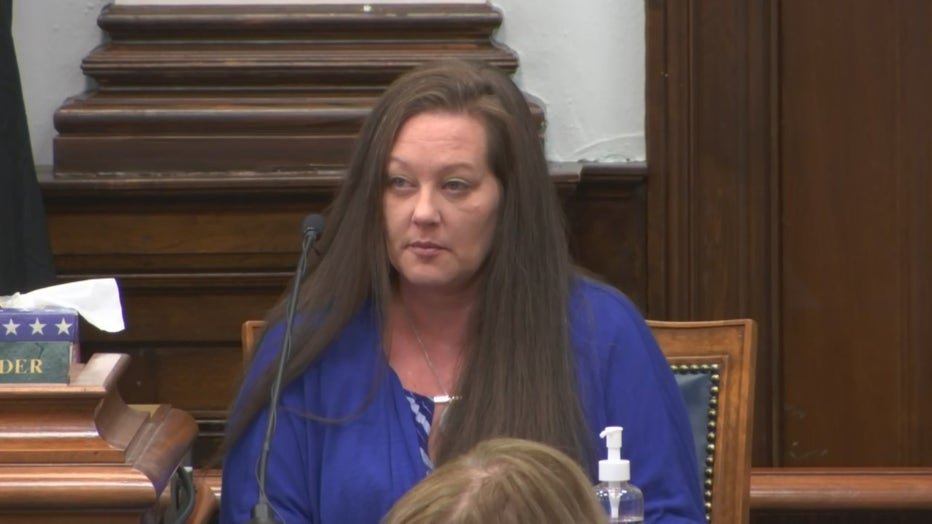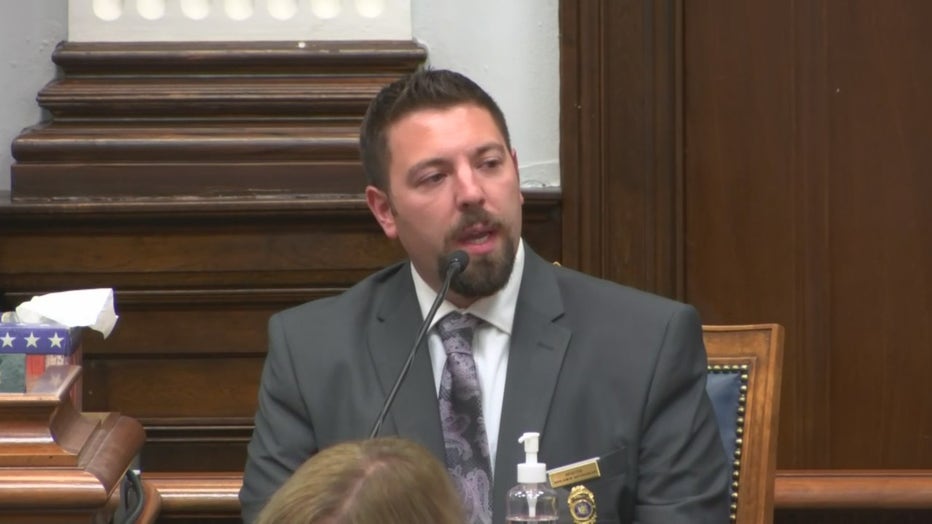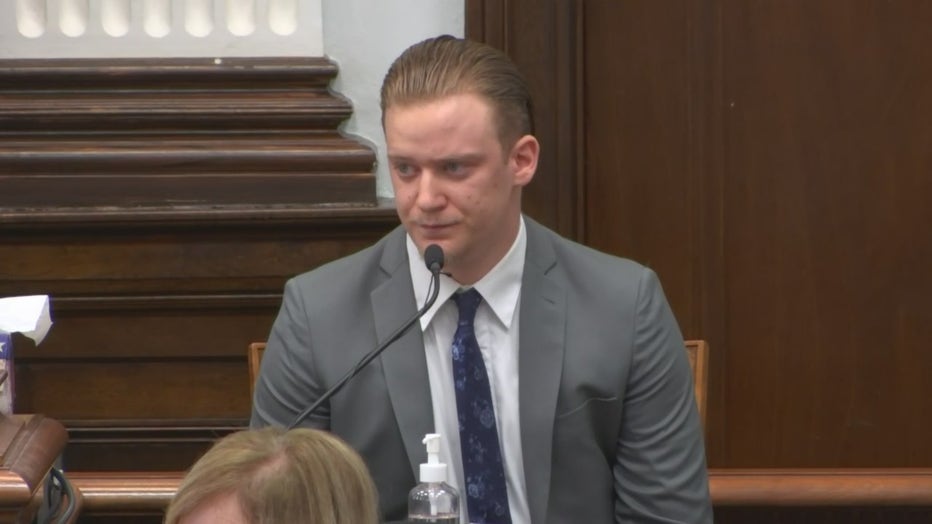Kyle Rittenhouse trial: How 2 weeks of testimony unfolded in Kenosha

KENOSHA, WISCONSIN - NOVEMBER 10: Kyle Rittenhouse testifies about Gaige Grosskreutz holding a gun toward him during his trial at the Kenosha County Courthouse on November 10, 2021 in Kenosha, Wisconsin. Rittenhouse shot three demonstrators, killing
KENOSHA, Wis. - The Kyle Rittenhouse trial has gripped southeast Wisconsin and the rest of the nation for two weeks straight. It was packed with high drama and courtroom fire between the attorneys and judge. It also provided plenty of talking points for all those watching and taking it in live streams on FOX6Now.com, the FOX6 News app, and the FOX6 News social media channels.
Below is a recap of how the trial played out – day by day.
Monday, Nov. 1
Jury selection

In an all-day session that ran well past dark, 20 people — 12 jurors and eight alternates — were selected. The judge said he would decide at the end of the trial which ones are alternates and which ones will deliberate. The 20 consists of 11 women and nine men.
Tuesday, Nov. 2
Opening statements
Jurors heard starkly different portrayals of Kyle Rittenhouse — instigator or victim — in the opening statements.

Kenosha County Prosecutor Thomas Binger
Prosecutor Thomas Binger said Rittenhouse set the bloodshed in motion when he triggered a confrontation with a man that night and then killed him with a bullet to the back.

Kyle Rittenhouse defense attorney Mark Richards
But Rittenhouse's attorney, Mark Richards, told the jury that his client acted in self-defense after the man tried to grab Rittenhouse's gun and others kicked the teen in the face and clubbed him in the head with a skateboard.
Testimony begins
The first state witness was Dominick Black, who bought the rifle for Rittenhouse in Ladysmith.

Dominick Black
Prosecutors then called FBI agent Brandon Cramin to testify about infrared surveillance video of the protest on the night of the shooting. Prosecutors have said previously that the video would show that it was Rittenhouse following or chasing Rosenbaum at one point. They played a grainy video from 8,500 feet in which figures on the ground weren’t immediately identifiable. After a dispute between the two sides over whether additional surveillance videos exist that the defense hadn’t seen, Cramin, who testified off-camera by the court's order, was asked by the judge if he could return and testify another day.
SIGN UP TODAY: Get daily headlines, breaking news emails from FOX6 News
The third state witness was Koerri Washington, a self-described social media influencer who was there the night of the shootings to livestream. He captured the events leading up to the shooting including a sequence of gunshots. His video was played for the jury.
Wednesday, Nov. 3
Prosecution testimony
Koerri Washington's testimony continued.
The jury watched one of the central pieces of video evidence — footage of a man chasing Rittenhouse and throwing a plastic bag at him just before the man was gunned down.

Koerri Washington
Someone is heard yelling "F--- you!" followed by the sounds of the four shots Rittenhouse fired, killing Joseph Rosenbaum, though the shooting itself is not clearly seen on camera.

Kenosha Detective Martin Howard began his testimony. He was assigned to investigate the Rittenhouse shootings and gathered video, including from witnesses.
Just before the end of the day, prosecutors called to strike Juror #7 over a joke to a deputy.
Thursday, Nov. 4
Prosecution testimony
Before testimony resumed Thursday, the judge dismissed the juror who had made a joke to a court security officer about the police shooting of Jacob Blake. The juror, a retired man, declined to repeat the joke for the judge.

Martin Howard, Kenosha Police Department
Kenosha Detective Martin Howard finished his testimony, testifying that video footage shows that a protester, Joshua Ziminski, had fired the first shot into the air. Howard said he used a stopwatch and timed five or six videos to determine that 2.5 seconds later, Rittenhouse began firing at Joseph Rosenbaum.

Richard McGinniss
Richie McGinniss, who was recording on a cellphone for the conservative website The Daily Caller, took the stand and described watching as Joseph Rosenbaum chased down Rittenhouse in one of the most crucial and disputed moments of the night. It is one of the few moments not clearly captured on video.

Ryan Balch
Ryan Balch, a former Army infantryman who carried an AR-style rifle that night and walked around patrolling the streets with Rittenhouse, testified that Rosenbaum was "hyperaggressive and acting out in a violent manner," including trying to set fires and throwing rocks.
Friday, Nov. 5
Prosecution Testimony
Jason Lackowski, a former Marine who was armed in Kenosha during the protests to help protect businesses, testified that Rosenbaum – the first man shot and by Rittenhouse – was acting "belligerently" and "asked very bluntly to shoot him." Lackowski added that Rosenbaum was acting like a "babbling idiot" and did not appear to pose a serious threat.

Jason Lackowski
Rosenbaum's fiancee, Kariann Swart, also took the stand. She disclosed that Rosenbaum was on medication for bipolar disorder and depression but didn't fill his prescriptions because the local pharmacy was boarded up as a result of the unrest. He had been released from a Milwaukee hospital the day he was killed, admitted after a suicide attempt; the jury was not told why he was admitted. Swart said she told Rosenbaum not to go to Kenosha because of the unrest.

Kariann Swart
The aunt of Huber, the second man shot and killed, testified. Susan Hughes said her nephew knew Jacob Blake. The prosecution wanted to bring up a heroic act of Huber's, while the defense wanted to bring up his criminal history; neither was presented to the jury.
Witnesses testified that Rosenbaum, who was unarmed, angrily threatened to kill Rittenhouse and lunged for his gun. A crime lab DNA analyst took the stand. She said there was no DNA from Rosenbaum or Huber on the weapon, but that she had no way of knowing if Rosenbaum touched it.
Rosenbaum and Huber were shot outside a car dealership. Workers from the car dealership testified that they did not ask anyone to protect the property amid the unrest. One worker said he spoke to Rittenhouse before the shootings.
Monday, Nov. 8
Prosecution Testimony
Gaige Grosskreutz, the third man shot in this case, took the stand Monday and recounted how he drew his own pistol after the bloodshed started. He said he thought Rittenhouse "was an active shooter" and that he (Grosskreutz) "was going to die."
Grosskreutz was shot in the arm, tearing away much of his bicep — or "vaporized" it, as the witness put it.

Gaige Grosskreutz
Grosskreutz said he had gone to the protest in Kenosha to serve as a medic, wearing a hat that said "paramedic" and carrying medical supplies, in addition to a loaded pistol. He said his permit to carry a concealed weapon had expired and he did not have a valid one that night. Grosskreutz testified that he volunteered as a medic at protests in Milwaukee in the days after George Floyd died under the knee of a Minneapolis police officer in May 2020. Grosskreutz said he attended around 75 protests before the night he was shot, offering help to anyone needing medical attention. He said he provided medical assistance to about 10 other people that night in Kenosha.
He said he went into action after seeing Rittenhouse kill a man just feet away — the second person Rittenhouse fatally shot that night.

Kenosha Police Department Det. Ben Antaramian
Also testifying was a member of the Wisconsin State Crime Lab, Heather Williams, a police officer and someone who was streaming the night of the shootings.
The jury also watched new high-quality drone footage showing the fatal shooting of Rosenbaum.
Tuesday, Nov. 9
Prosecution Rests

James Armstrong, senior forensic imaging specialist with the Wisconsin State Crime Lab
James Armstrong, a forensic imaging specialist began to testify in regard to video in the case as court resumed Tuesday morning, the state's final day of testimony.
Before testimony began, however, it was revealed a deputy spotted someone video recording the jury, whose privacy is paramount during such a high-profile criminal case. Judge Schroeder said officers approached the person and required them to delete the video before returning the person's cellphone, adding the sheriff's office was instructed that if it happens again, to take whatever recording device it may be. It's unclear who the person was. The sheriff's department is investigating this information and working with the courts.

Dr. Doug Kelley, forensic pathologist
Dr. Doug Kelley with the Milwaukee County medical examiner’s office was one of the final witnesses for the state before prosecutors rested their murder case after 5 1/2 days of testimony. The first man killed by Rittenhouse was shot at a range of just a few feet and had soot injuries that could indicate he had his hand over the barrel of Rittenhouse’s rifle, but it was unclear from video footage whether Joseph Rosenbaum was grabbing for Rittenhouse's gun or trying to swat it away, said Dr. Kelley.
Defense Testimony
The defense called as its first witnesses people who were on the streets with Rittenhouse that night and described him as pale, shaking, sweating and stammering after the shootings.

Nicholas Smith
"He repeats, ‘I just shot someone,’ over and over, and I believe at some point he said he had to shoot someone," testified Nicholas Smith, who said he had gone to the protests that shook Kenosha that night at the request of the owners of a car dealership to protect the business.
"My God, my life might be over," another witness, JoAnn Fiedler, quoted Rittenhouse as saying. She said he didn't give any details about what happened but told her he "had to do it."

JoAnn Fiedler
Fiedler, the defense witness, was with Rittenhouse outside the car dealership just before the first shooting and said they were being shouted at and taunted by protesters, including Rosenbaum. But Fiedler, who said she carried a pistol, testified she never saw Rittenhouse threaten or point his gun at anyone.
On Tuesday, the jury watched drone video that was zoomed-in and slowed down to show Rosenbaum following Rittenhouse, and then Rittenhouse wheeling around and shooting Rosenbaum at close range. Kelley said Rosenbaum was shot four times by someone who was within 4 feet of him. He testified that Rosenbaum was first wounded in the groin and then in the hand and thigh as he faced Rittenhouse, and then was shot in the head and in the back.

Kyle Rittenhouse
Those final two shots were at a downward angle, the pathologist said. Prosecutors have said this indicates Rosenbaum was falling forward, while defense attorney Mark Richards said Rosenbaum was lunging. Kelley said both scenarios were possible.
The drone footage was the clearest video yet of the shooting that set in motion the bloodshed that followed moments later.
Wednesday, Nov. 10
Defense Testimony
Kyle Rittenhouse took the stand in his own defense Wednesday, testifying he was under attack when he killed two men and wounded a third with his rifle during a chaotic night of protests in Kenosha, saying: "I didn’t do anything wrong. I defended myself." At one point, Rittenhouse sobbed so hard the judge called a break.

Kyle Rittenhouse
In an account largely corroborated by video and the prosecution’s own witnesses, Rittenhouse said that the first man cornered him and put his hand on the barrel of Rittenhouse's rifle, the second man hit him with a skateboard and the third man came at him with a gun of his own.
Rittenhouse said he "didn't want to have to shoot" Joseph Rosenbaum, the first man to fall that night, but he said Rosenbaum was chasing him and had threatened to kill him earlier.
Rittenhouse testified that he then shot and killed protester Anthony Huber after Huber struck him in the neck with his skateboard and grabbed his gun. Then he wounded Gaige Grosskreutz, saying the protester had lunged at him "with his pistol pointed directly at my head."
His nearly all-day testimony was interrupted by an angry exchange in which his lawyers demanded a mistrial over what they argued were out-of-bounds questions asked of him by the chief prosecutor. The judge, though plainly mad at the prosecutor, did not immediately rule on the request.

Judge Bruce Schroeder
Thursday, Nov. 11
Defense Rests
The defense rested its case Thursday, setting the stage for closing arguments Monday. Rittenhouse's lawyers put on about 2 1/2 days of testimony to the prosecution's five, with the most riveting moment coming when the now-18-year-old told the jury that he was defending himself from attack.

Dr. John Black, Force Science Institute
One of the final witnesses for the defense was a use-of-force expert, John Black, who testified that less than three seconds elapsed between the time somebody fired a bullet in the air and Rittenhouse opened fire on Rosenbaum, the first man he shot.
Before the defense rested its case, attorneys sparred about whether an enlarged image taken from a drone video could be admitted into evidence. Schroeder, following arguments held without the jury present, said he would allow the image while admitting he didn't understand the technology used by a state crime lab employee to enlarge it.

Kenosha County Judge Bruce Schroeder
Wisconsin crime lab employee James Armstrong testified, under questioning from defense attorney Corey Chirafisi, that the software program adds pixels to the image and he cannot say with certainty what color the added pixels are. Schroeder used a magnifying glass to examine the image in question and also walked right up to a large screen to get a better look. He ultimately allowed the image to be admitted, but Rittenhouse’s defense attorney was also permitted to question the crime lab analyst about the software used to enlarge it with the jury present. The judge said he was leaving it up to the jury to decide how much weight to give the image.

James Armstrong, senior forensic imaging specialist with the Wisconsin State Crime Lab
Prosecutors said they would ask Judge Schroeder to allow the jury to consider possible lesser charges on some of the counts.

Kyle Rittenhouse
The judge said he would permit up to 2 1/2 hours per side for closing arguments, with jury instructions expected to take 45 minutes before the closing arguments.
Friday, Nov. 12
Attorneys, judge debate jury instructions
The jurors who will decide Kyle Rittenhouse’s fate will be allowed to consider lesser charges if they opt to acquit him on some of the original counts prosecutors brought, the judge said Friday during a contentious hearing in which both sides could claim partial victory.

Defense Attorney Corey Chirafisi, Kyle Rittenhouse
Wisconsin law allows the prosecution and defense to ask that jurors be told they can consider lesser charges as part of the instructions they receive before deliberating. Defense lawyers can object to lesser charges, and in some cases Friday, they did. For those that they didn't object to, Judge Bruce Schroeder asked Rittenhouse to confirm that he agreed with his attorneys' decision.
Schroeder told Rittenhouse that by including the lesser charges, "you’re raising the risk of conviction, although you’re avoiding the possibility that the jury will end up compromising on the more serious crime. And you’re also decreasing the risk that you’ll end up with a second trial because the jury is unable to agree."
Rittenhouse said he understood.

Kenosha County Judge Bruce Schroeder
Schroeder said he would issue his final rulings Saturday, but he made some findings from the bench and indicated how he might rule on others. For counts where jurors will be allowed to consider lesser charges, they will be instructed to only consider them if they first acquit Rittenhouse of the more serious original corresponding charge.
Friday's arguments over jury instructions were contentious at times, with attorneys rehashing debates they had earlier in the case. At one point, as prosecutors were seeking to add an instruction that would allow the jurors to consider whether Rittenhouse was provoked, the two sides debated about what a particular photo showed. Schroeder lost his temper, snapping: "You’re asking me to give an instruction. I want to see the best picture!"
Schroeder ultimately said he would allow the provocation instruction, which would ask the jury to consider whether Rittenhouse provoked Rosenbaum into attacking him. If the jury finds he did, that would negate self-defense.
Associated Press contributed to this report.

